(that will make you feel like a heroine of a Gothic novel)
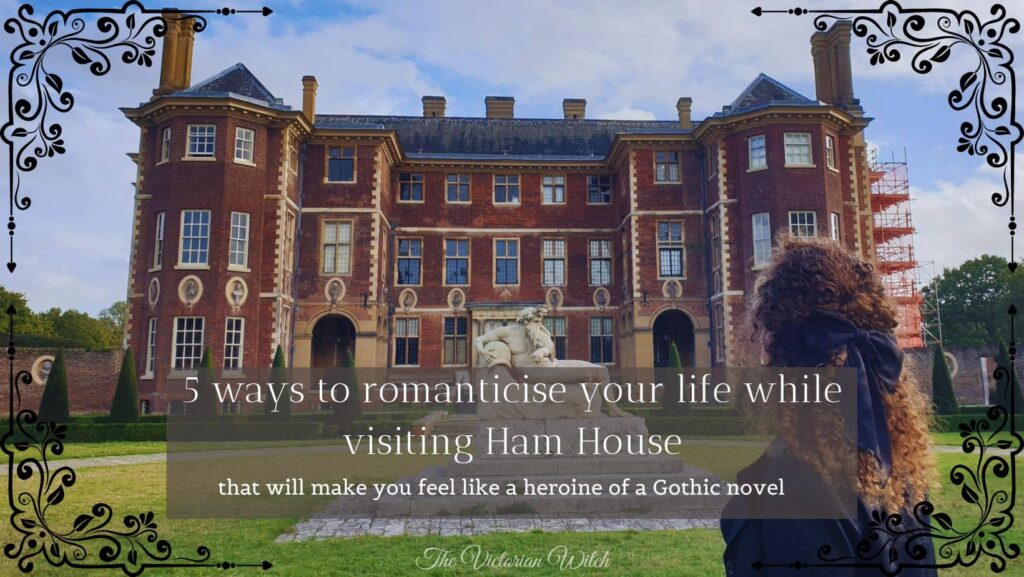
A Gothic fantasy house
If there ever were a grand house in England that epitomizes the ‘Spooky season’ for me, it’s undoubtedly Ham House. There are numerous opportunities here to be captivated and have your breath taken away by the incredible history, Gothic interiors, and romantic stories of the place, which are shared by wonderful and dedicated volunteers.
Ham House is located in Richmond, next to what remains of the grand houses that once proudly stood along the banks of Thames. It’s a splendid Grade I listed seventeenth-century house, constructed in 1610, accompanied by a magnificent garden. If you’re seeking your next Gothic adventure, you’re on the right path. Discover the romantic history of the English Civil War and how one woman’s clever maneuvering saved it by playing both sides.
A brief history of Ham House
The house was constructed by Thomas Vavasour. He was a naval captain who, unsurprisingly, desired a home of his own after retiring from his sea adventures. In 1626, the house was acquired by William Murray. He had grown up with Charles II due to the fact that William’s father served as Charles’ tutor.
William had the unenviable role of being the ‘whipping boy’. When a king misbehaved, he couldn’t be punished, so instead, the whipping boy was chastised. It was a rather unglamorous position, but the silver lining was that it typically came with generous rewards afterward. If those handsome rewards include Ham House, all the better!
In 1637-9, Murray modernized the house in the latest French court fashions, much of which you can still see today.
Let’s embark on an adventure and discover ways to immerse yourself in the 17th-century romantic fantasy of Ham House!
1. Learn the epic story of an unruly Duchess
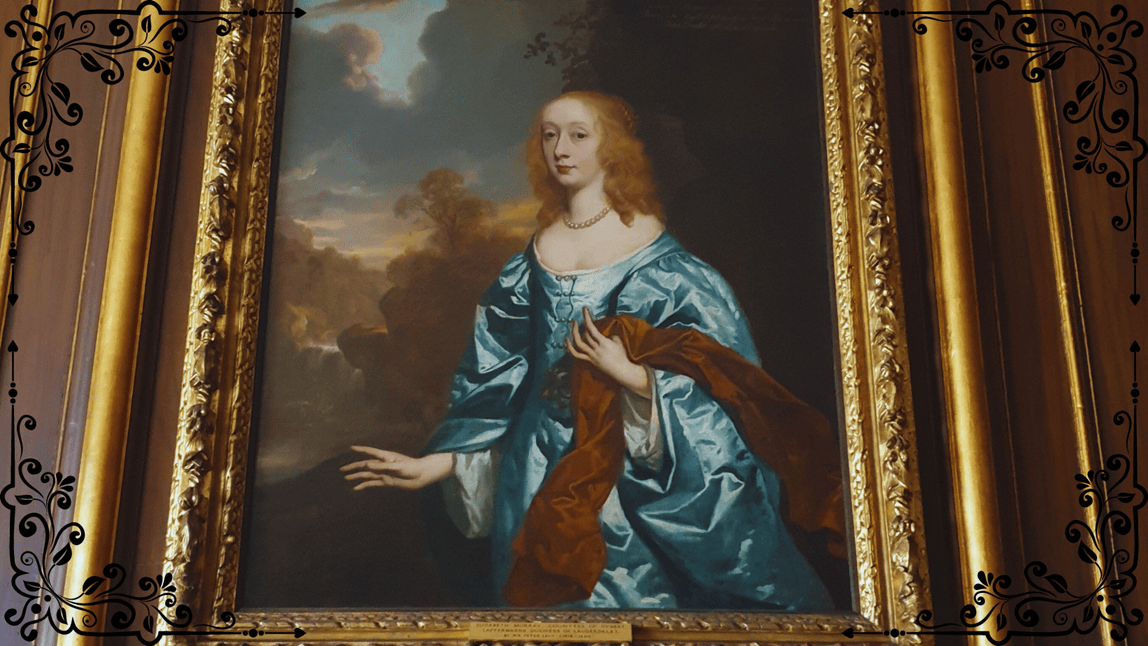
Every great house needs a heroine we can root for. A great lady who was ahead of her time in her thinking and didn’t conform to the rules of society, thereby leaving a lasting impression. Elizabeth Maitland is one such lady. If the ghost stories are to be believed, her larger-than-life presence still lingers within these walls, unsettling the peace of the staff and current inhabitants.
When the English Civil War started in 1642, William Murray, the owner of Ham, was exiled. He left the responsibility of preserving Ham to his wife Katherine Bruce and their two daughters. After Katherine’s death in 1649, her eldest daughter, Elizabeth Murray, assumed control. She also inherited the title of Countess of Dysart in her own right. This was unusual but a specific aspect of the peerage.
Playing both sides
Elizabeth Dysart cleverly managed to play both sides. She remained loyal to the Royalists while also developing a close friendship with Oliver Cromwell during the English Civil War. One can only imagine the level of skill and intrigue that must have entailed. In 1648, Elizabeth married Lionel Tollemache and bore him 11 children, but her marriage to John Maitland, the Duke of Lauderdale, in 1672 was her jackpot. The couple had no children, so they devoted all their efforts to the transformation and embellishment of Ham House.
Upon the duke’s death, he bequeathed most of his estates to Elizabeth. Nevertheless, in her old age, she had to mortgage the house due to the extravagant spending during the golden years of Ham. To be fair, I might have done the same if I were in her shoes. After all, you only live once, as the saying goes!
Elizabeth Maitland passed died in Ham, impoverished and alone, which cast a rather somber conclusion to such an illustrious life. However, the fact that we can still embrace her story by immersing ourselves in the house she created speaks volumes. The house endures, and hopefully will for centuries to come. If that isn’t a testament to a successful life’s work, I don’t know what is.
2. Immerse yourself in the atmosphere of the moody interior of the Ham House
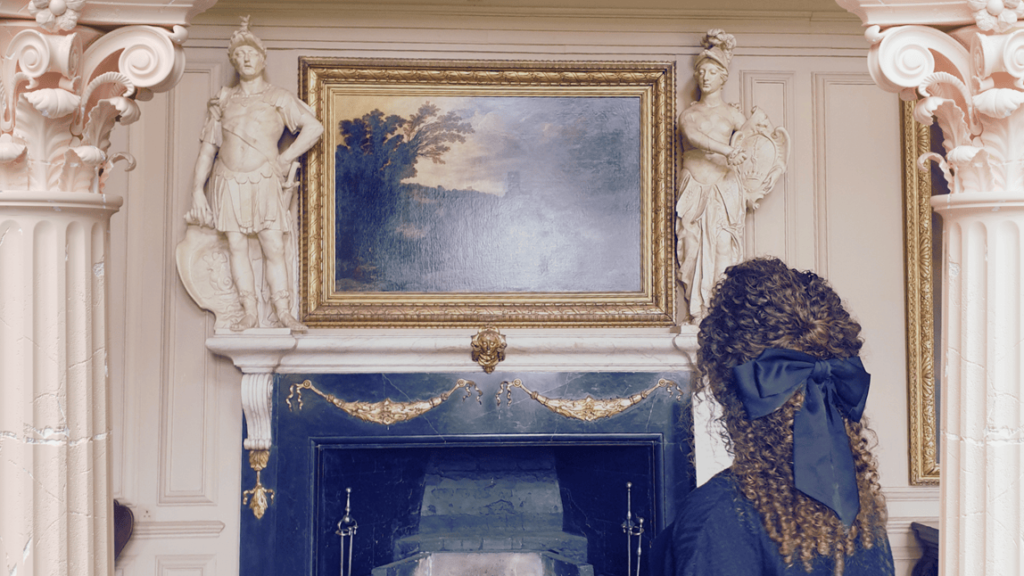
The house is a 17th-century gem. The interiors have been faithfully recreated and renovated in the style that reflects the house in Elizabeth Maitland’s time. The availability of different areas of the house for viewing depends on the number of volunteers present. I visited twice, and it was only on my second visit that I was able to explore the set of South rooms, including the Duchess’s bedroom!
The Chapel
The Chapel is quite dimly lit to preserve the delicate displays and is accompanied by a ghost story. When the Duke of Lauderdale passed away, his body lay in state there for a week. In 1992, during restoration work, a couple of workers entered the chapel early one morning and discovered marks of a skirt in the dust on the floor. Several accounts have mentioned the sighting of a figure dressed in black kneeling at the altar. To be honest, it’s not difficult to imagine such occurrences in this dark and eerie space.
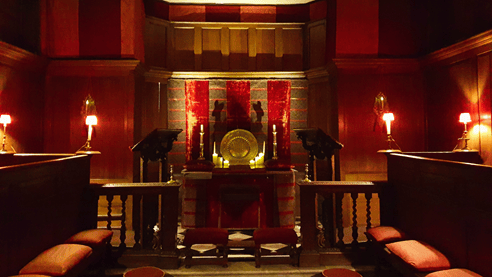
The Staircase
The staircase is my second favorite place in the house, right after the duchess’s closet. It was meticulously designed to leave a lasting impression, offering the grandest route possible to William Murray’s state apartments. I must admit, it worked! The balustrade of the staircase features intricate carvings of trophies of arms that were once hung in the Great Hall. As for the pictures on the walls, they are early copies of some of the most magnificent works from the collections of Charles I and Philip IV of Spain.
Just picture yourself running up these stairs, clutching a long dress with its trailing train following gracefully, guided only by the warm glow of candlelight.

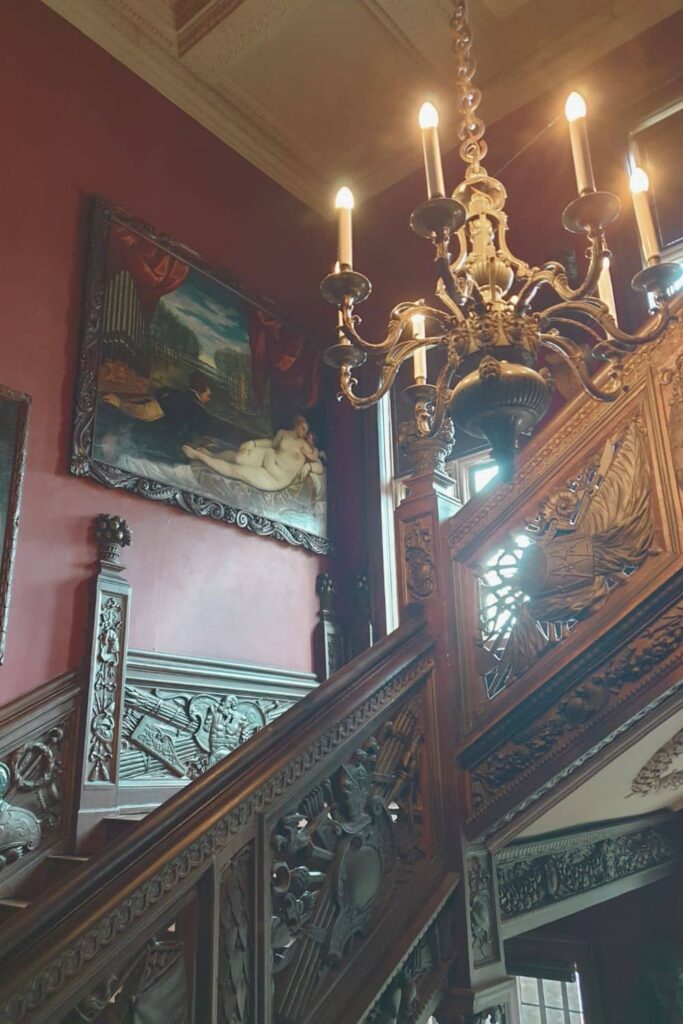

The Round Gallery
The Round Gallery was initially used as a dining room. During the expansion of the house, they cut a hole in the floor to provide a more splendid view from the great hall situated below. It is in this space (in the far end) that you will discover the painting of The Duke and Duchess of Lauderdale by Sir Peter Lely.
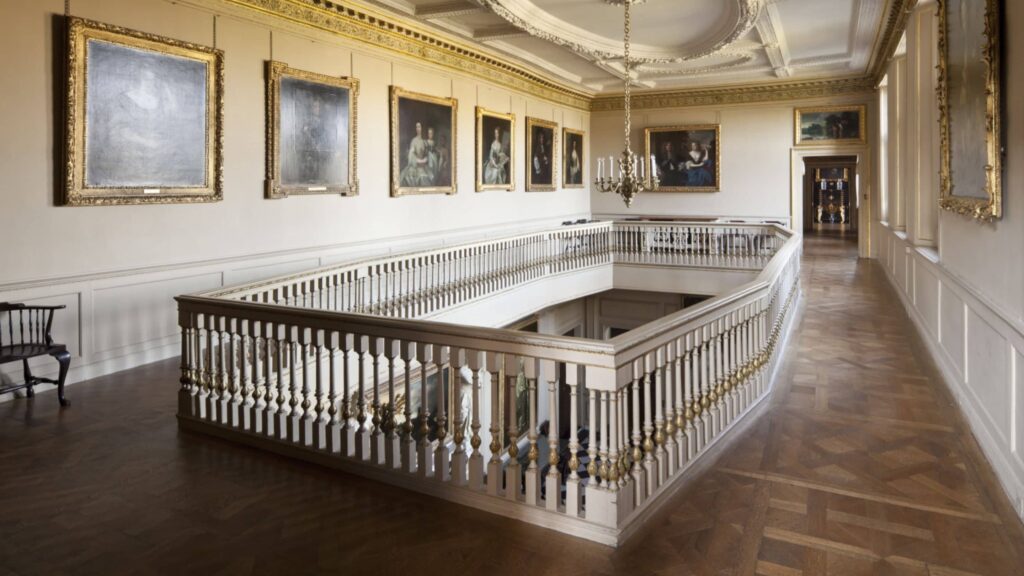

The Long Gallery
The Long Gallery provides a perfect setting for a Gothic novel. I may or may not have attempted to romantically run through it (always mindful not to run into any elderly visitors, of course). The portraits of 17th-century nobility contribute significantly to the overall atmosphere. You can readily identify them by consulting the list conveniently placed next to the door.

The Queen’s Bedchamber and Closet
I was pleasantly surprised to find the Queen’s bedchamber completed during my recent visit. The last time I came, they were doing conservation work. The Queen in question is Catherine of Braganza, wife of Charles II. In every grand house, there exists a state room designated for the monarch in the event they choose to spend the night, even if it’s just once. In my opinion, any reason to create a splendid set of rooms is a valid one. According to the records, the Queen did, in fact, stay here only once.
William Bradshaw wove the intricate tapestries. Inspired by French pastoral scenes, they depict nicely dressed nobles frolicking in a picturesque setting – cottagecore much?
My favorite parts of the house are the small closets adjacent to the main bedrooms. I might sound somewhat uninformed here, but I haven’t come across such spaces elsewhere. Please feel free to correct me if I’ve overlooked any houses with this specific interior feature, but as of now, this is the only one of its kind that comes to mind.
These charming closets offer an ideal retreat from society. Especially since the main bedroom was considered a public room where guests were received. If someone came to your bedroom and found you absent, with the door to your closet closed, it signified your desire not to be disturbed while you sat, read, wrote, or daydreamed in peace. In an era without central heating, these rooms were a dream to have, featuring a fireplace and a small space that could be easily heated. They were likely the warmest places one could find!
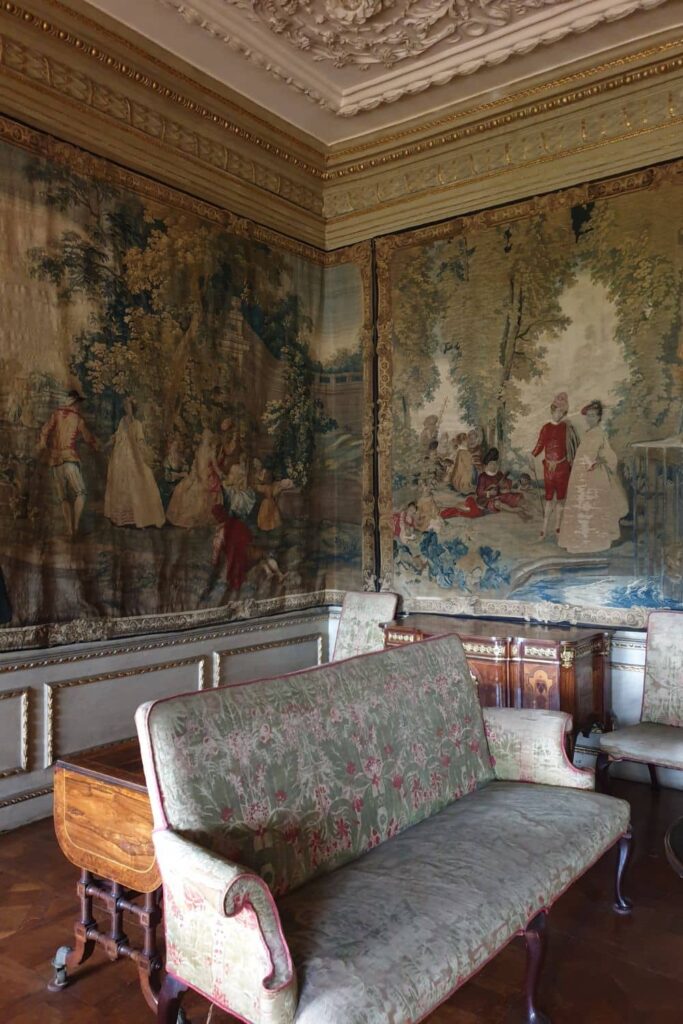


The Duchess’ Bedchamber
And, of course, at the end of the family room tour we have the Duchess’ bedchamber and the Duke’s closet. A mesmerizing portrait of young Elizabeth graces the center wall of the room. They have chosen not to place a bed in this space but, instead, showcase these reclining chairs that underwent a £100,000 renovation. At that price, I’d certainly choose to put them on display as well! I didn’t get a good picture of the space, so these will have to do!
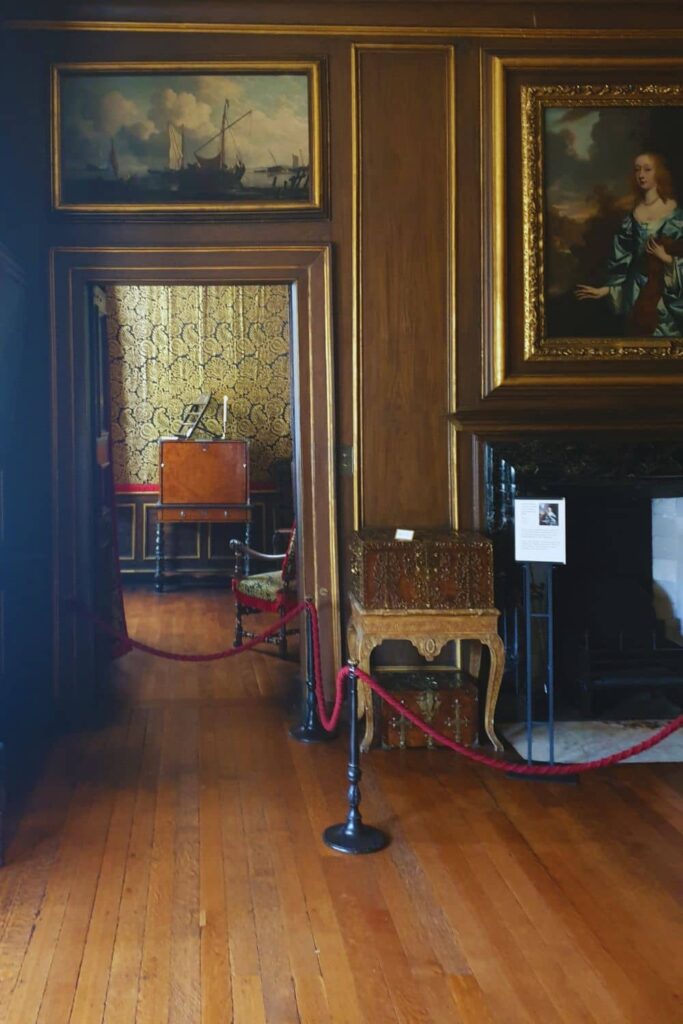
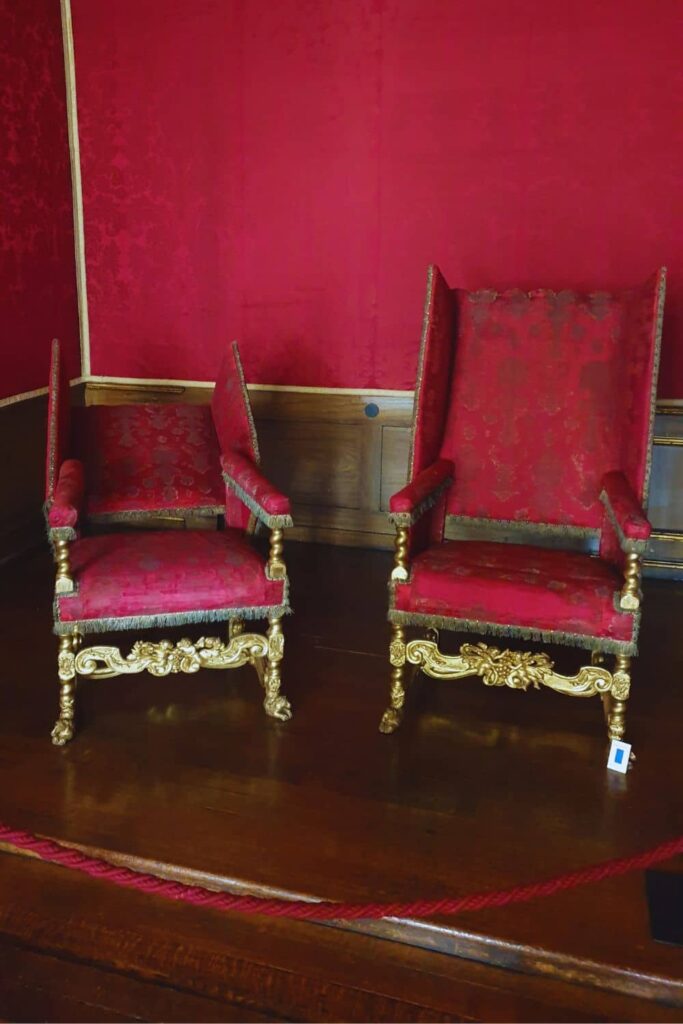
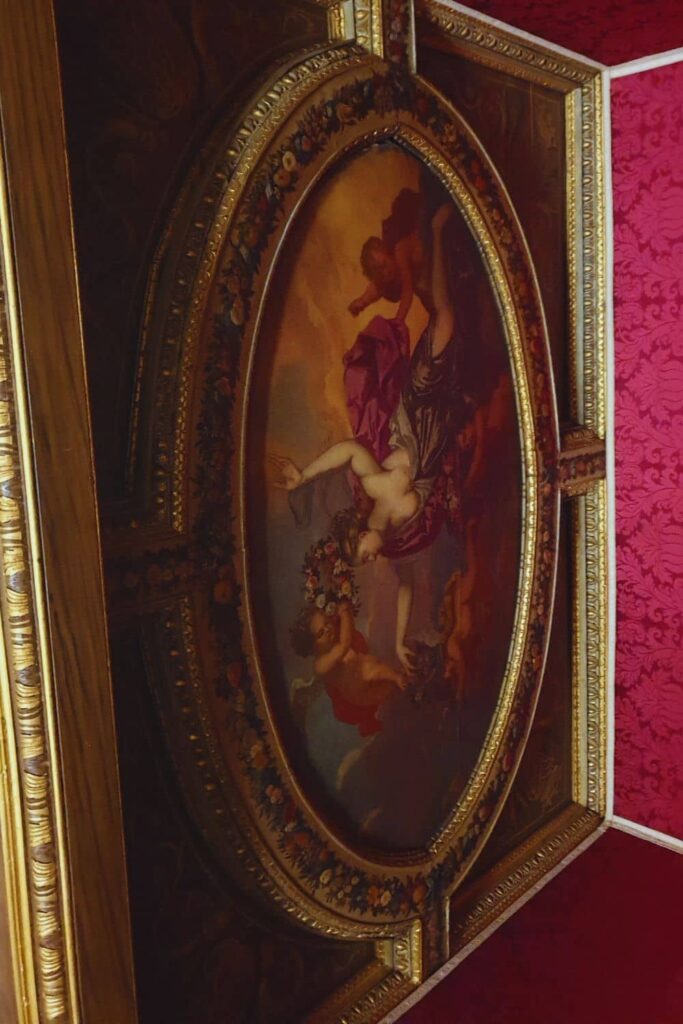
Additionally, the Duchess had her own private retreat, a charming little getaway closet where she or the Duke could seek solitude when needed. I find the concept of the closet quite fascinating, akin to having your own ornate miniature office.
3. Discover The Most Haunted House in London
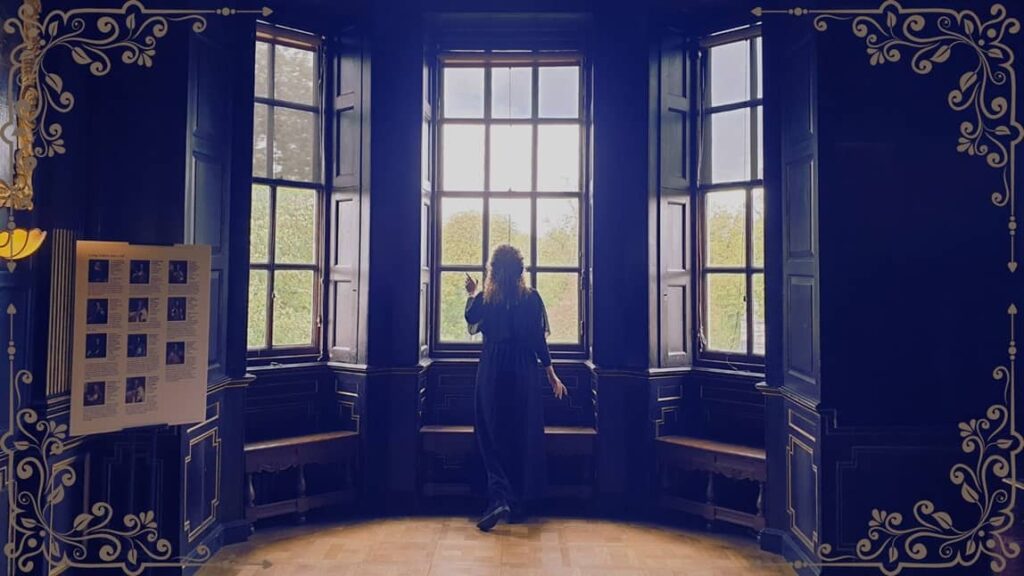
This is, without a doubt, my absolute favourite topic to discuss with the staff and volunteers at grand houses. I do love a good ghost story! Ham House is renowned for being one of the most haunted locations in Britain. I must admit that I haven’t personally encountered any ghosts at Ham House. I suspect it might be because I’m so excited about them, which probably makes them avoid me.
In my experience at Kew Palace, I didn’t witness or sense anything unusual during my first two seasons working there. However, in my third season, things took a different turn (but that’s a story for another time).
There are many ghost stories linked to Ham House. So much so that they have produced a booklet titled ‘Haunted Ham House – A Guide to the Ghosts of Ham House,’ which is available for purchase in their shop for £1.50. I thoroughly enjoyed it! These stories range from mysterious sounds emanating from the attic to the apparition of a small ghost dog. However, the most prominent and captivating specter, of course, is that of the Duchess herself.
There is a fascinating story about a young girl who claimed to have witnessed the ghost, which led to the discovery of mysterious documents. These documents supposedly proved that the Duchess had murdered her first husband so she would be able to marry the Duke of Lauderdale. However, it’s worth noting that these ‘papers’ were never found, and the story remains unverified.
I can very well imagine the Duchess walking her beloved halls at night, inspecting her property and reminiscing of her illustrious life there. All the parties, secrets, births, deaths, dances and dinners – it must have been a life you wouldn’t want to leave for good.
4. Explore The first bathroom in Britain
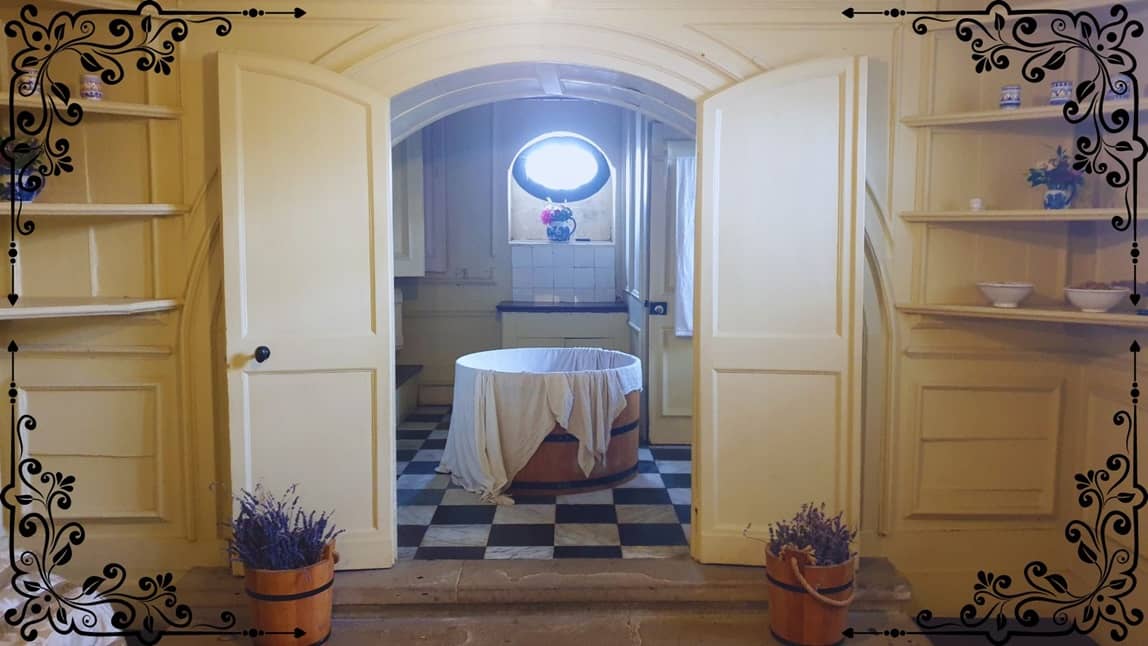
Ham House has a fascinating downstairs area. Here visitors can explore the servants’ quarters, witness a well-equipped kitchen complete with food examples and demonstrations, look at storage areas, and discover lots of cool stuff. However, the standout attraction is the Duchess’s bathroom, which is said to be one of the earliest indoor bathrooms in Britain.
The Duchess cared so much about cleanliness that she relocated her bedroom to provide more convenient access to the bathroom. While the bathroom on display is a reproduction, it likely closely resembles its historical counterpart. The tent-like canopy would have created a steamy ambiance for the Duchess’s spa treatments. In the larger room, you can find a little daybed where she would have relaxed, applied creams, luxurious oils, and enjoyed massages.
5. Run through the formal gardens of Ham House like a princess
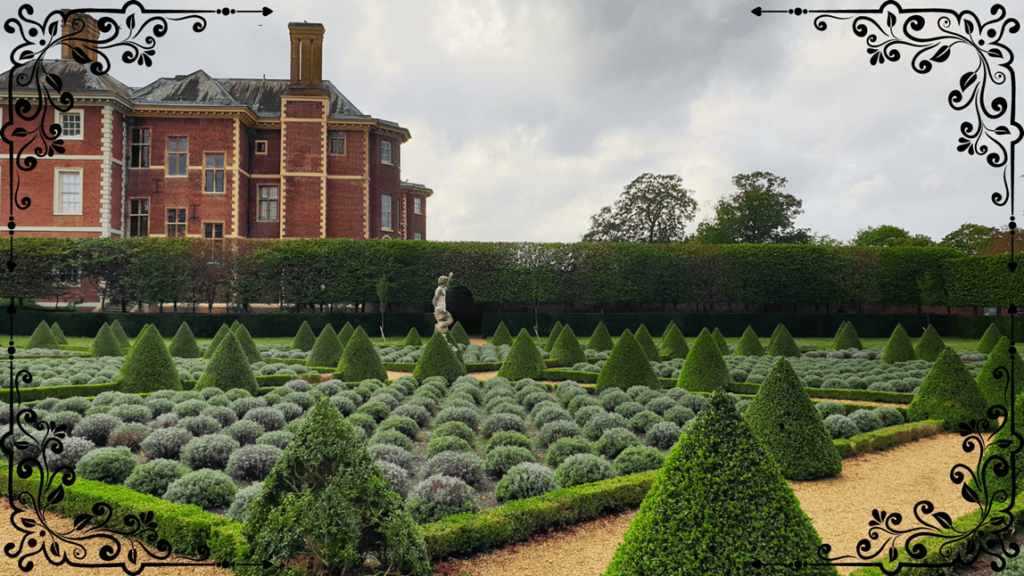
The back garden was carefully restored to resemble the 1672 plan by John Slezer and Jan Wyck. In the 18th century, it underwent a transformation into English-style romantic landscape gardens, a choice I find doesn’t quite suit Ham. Fortunately, the present day restored gardens are back how they used to be in the 17th century, and I’m so glad they were handled this way.
Charming statues of Hermes and Flora stand sentinel at the entrance to the garden. And because I am a big child, I couldn’t help but be fascinated by the oversized butt on Hermes statue — do you also think it looks a bit too big?
The strategically designed bushes practically beg for someone to glide through them in a long, flowing dress! I didn’t attempt it this time due to being too tired, but mark my words, I’ll be twirling through them come spring!
On the east side of the house, a delightful formal garden awaits, contributing to the mysterious Gothic ambiance with its inviting paths perfect for a whimsical run.
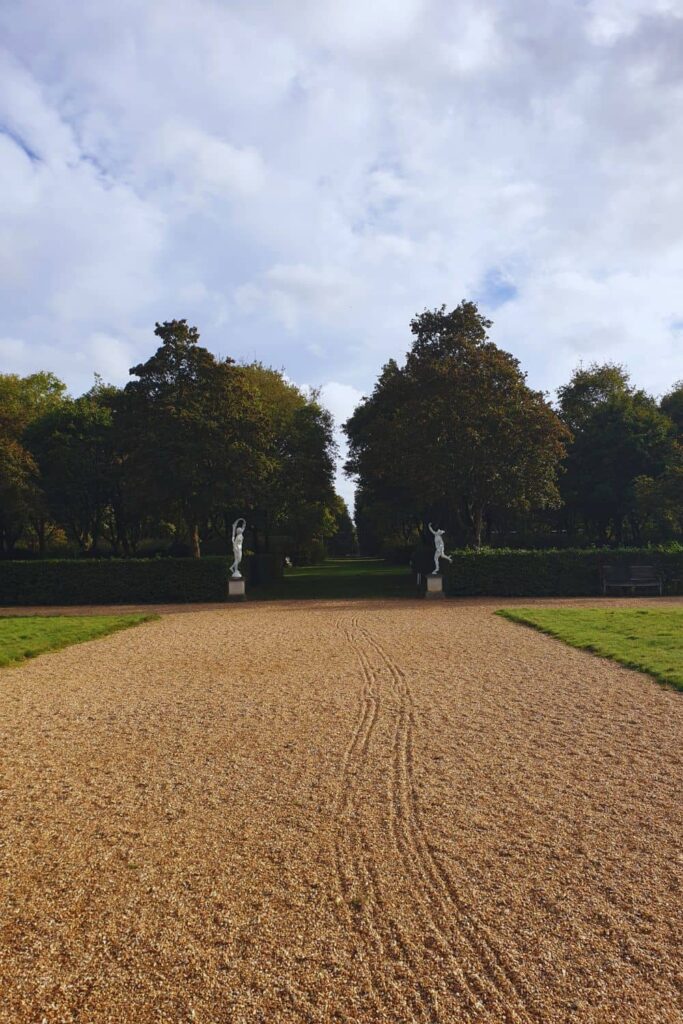
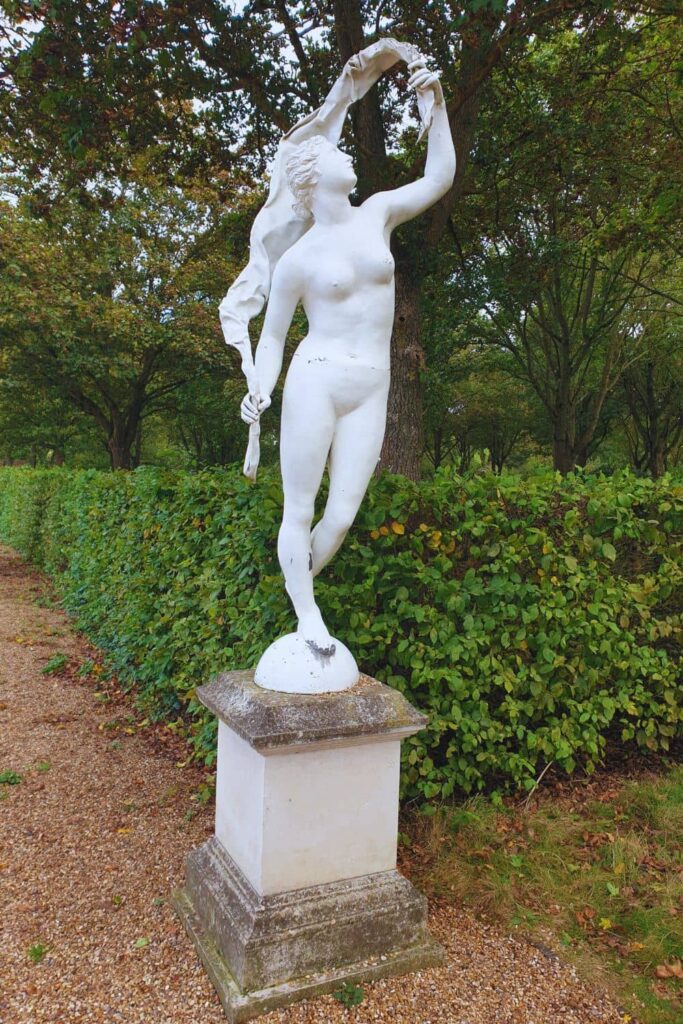
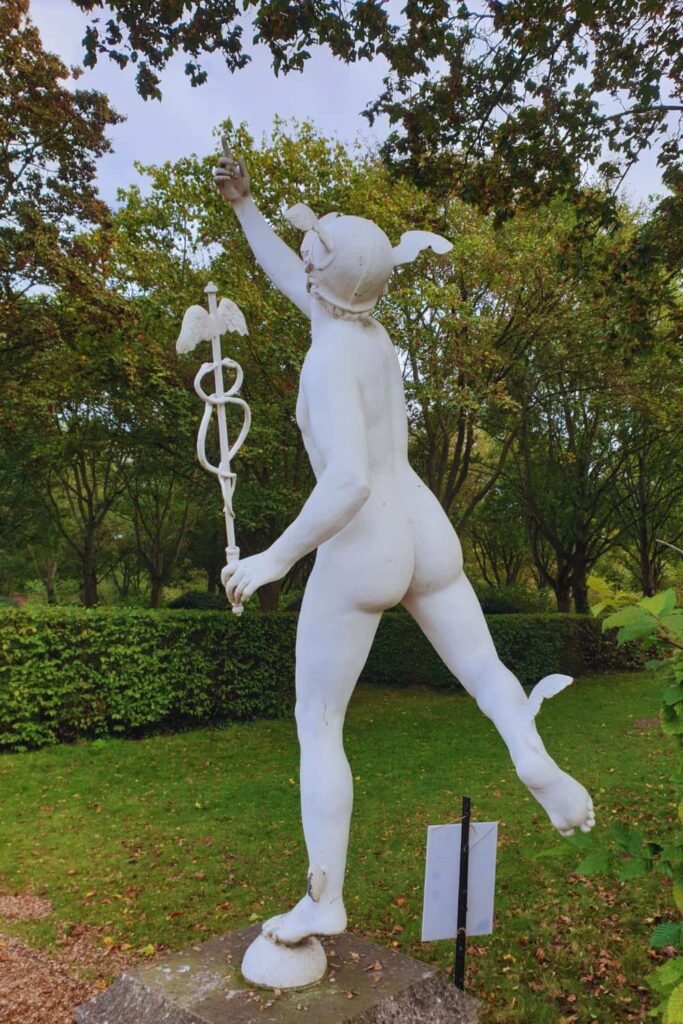
Ham House after Elizabeth
After Elizabeth’s death Ham House went into disrepair. The 4th earl Lionel Tollemache and his wife Lady Grace Carteret breathed a new life into Ham in the 18th century, reliving its glory days by enhancing and reconstructing it. Interestingly, they would have been contemporaries with Henrietta Howard of Marble Hill House, situated nearby along the river, although we have no records of them being friends!
Later on, the fifth earl was so secretive about his home that even King George III was denied entry. Horace Walpole, the uncle of the 5th earl and resident of the Gothic gem Strawberry Hill, described Ham as gloomy and desolate. The closed doors of Ham House would have provided Horace (author of the first English Gothic novel, ”Castle of Otranto”) inspiration for one of his stories —what mysteries could have unfolded within?
19th century
In the 19th century, under the reign of the sixth earl, improvements were made. The revamped decor even got praise from Queen Charlotte. In 1821, Louisa Manners, sister of the 6th earl, became a Countess in her own right, echoing the path Elizabeth had taken two centuries earlier—an intriguing tale in itself!
The Victorian era brought decay to Ham once again as it kept changing owners. By 1948, when it was handed over to the National Trust, Ham was in a less than ideal state. At least it wasn’t destroyed during the World War II, like so many other historic houses. Today, we are fortunate to still have Ham House. A testament to Stuart grandeur and a truly unique piece of history.
* * *
Ham House is said to be ‘’haunting’’ and having an unsettling vibe. I, personally, felt no such thing. It might be because I’m me—I live and breathe historic places and interiors that others might find spooky. Visitors in Kew Palace have asked me many times if I find it creepy. I honestly have no clue why they’d say that. Perhaps it’s a matter of people not being able to appreciate the nostalgic charm and serene comfort that these old-timey settings bring me. There’s absolutely nothing “creepy” about it (to me)!
The same holds true for Ham House. I experienced a sense of peace and ease throughout the time I spent there. Feeling surrounded by the richness of history, I moved through the space respectfully—a good practice in any situation.
I want more!
All the info on logistics and other practical things about visiting Ham House can be found here, on the National Trust Website.
For more romantic histories and fascinating heroines, as well as a bit of Magic – check out more of my blog articles.